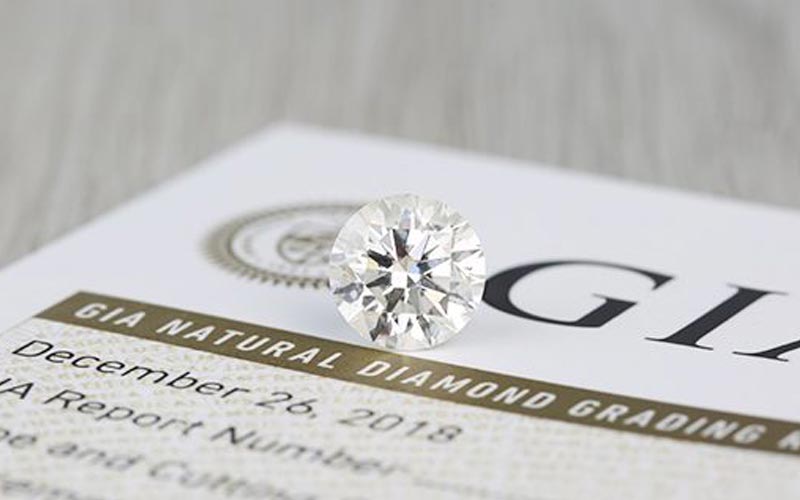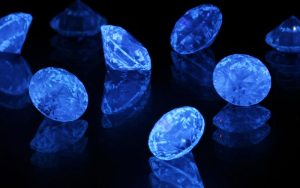
Every diamond is different and unique because of this characteristics, the 4C’s – cut, clarity, carat and colour. All the four C’s vary from diamond to diamond. These differences in the attributes can vary minutely for example a slight inclusion or colour variance. However these minute differences can majorly affect the pricing of a diamond. A professional gemmologist with expertise is required to know these difference and evaluate the diamond. Considering that pricing varies so drastically with every difference in the 4 C’s, one can never be sure if they are charged the correct value for the diamond with particular attributes. Diamond certifications standardise the characteristics of a diamonds so you don’t need a gemmologist or expert every time you go to purchase a diamond. Diamond certification are diamond standards set by Gemmological Institutions for the protection for consumers globally. These standards are accepted worldwide.
Diamonds and other gemstones receive certifications through globally accepted Gemmological Institutions. Precious stone is carefully assessed, appraised, compared, and then rated for quality after considering every attribute. Those gemstones that are Non-certified may carry a ratings or some documentations, but these are not official certificate from Gemmological institute, such as Gemological Institute of America (GIA) or American Gem Society (AGS) or European Gemmological Laboratory (EGL).
One of the best and most apparent advantage of getting a certified diamond or gemstone is the assurance about the real value of the diamond you have purchased.
– Proof of authenticity and ownership in case the diamond is stolen
– Proof of appraisal that helps determine the real value of the diamond
– Assurance of gem quality taking into consideration the 4C’s
The biggest disadvantage to buying certified diamonds is the premium price you end up paying for all assurance. However no matter the price bump, it is always recommended to buy diamonds that are certified for quality and value assurance.
Many prefer to go for non-certified diamond because of:
– Lower cost
– Less hassle with grade checking
– Wider collection
Even if non certified diamond are cheaper, this discounted prices carries with it a cost. Those who are not experts and don’t have an expertise can be easily manipulated by the jewellers. So while making a buying decision it is recommended to buy certified diamonds.
There are many institutions worldwide whose certification and standards are universally accepted. Amongst these are America Gem Society (AGS), European Gemological Laboratory and International Gemological Institute (IGI). Each institution has its own system of grading the diamonds, and all are recognized as expert authorities in the field of gem classification. However it is the GIA certification that matter the most.
Lack of transparency and unauthorised pricing of diamonds and gemstones have long been a pressing issue. The deal with this Gemological Institute of America (GIA), a non profit institution was started to regulate the diamond market. Over time, GIA has become the global industry’s standard for diamond grading and grading practices. The GIA founded in 1931, is said to be the world’s leading authority in gemmology. Its mission is to protect all the consumers as well as the sellers of diamonds and gemstones by setting and maintaining the standards used to evaluate gemstone quality. This prestigious institute has its headquarters in Carlsbad, California with laboratories and research centres spread across the world. With its universally acclaimed subject experts, GIA is a hub that functions a genuine source gem information centre for the common man and the trade and the global media channels. GIA certified diamonds, guarantees the buyers that every gemstone under the certificate has been evaluated by an unbiased gemmologist. GIA’s pioneering technology and strict grading standards ensures that maximum level of reliability, science, and professionalism is maintained. Therefore, GIA certificates carry a premium because it is the benchmark for certifying and grading diamonds around the globe. Not only are they known for their consistency and accuracy but their certificates are highly valued in the diamond industry. Each certificate is comprehensive and provide all the relevant information about the quality of the diamond. Each report are tagged with a unique identification number specific to GIA.
GIA certificate come in two forms: Diamond dossier and Diamond grading report. Dossier are report for diamonds under 1.00ct and it does not include GIA diamond plots. Grading report on the other hand includes diamond plot and are specific for diamonds over 1.00ct.
Line 1: Date of certification and unique GIA report number assigned to every graded diamond.
Line 2: The shape of a diamond and type of cut i.e. brilliant cut or step cut
Line 3: The length x width x height of the diamond.
Line 4: Identification of the 4 C’s of diamonds starting with the precise carat weight rounded to the nearest 0.01ct.
Line 5: The color grade.
Line 6: The clarity grade.
Line 7: The cut grade assigned (only for round cut diamonds).
Line 8: The polish grade
Line 9: The symmetry grade
Line 10: The fluorescence grade
Line 11: The clarity grade and inclusions that are found within the diamond.
Line 12: The inscription laser etched on the girdle of the diamond.
Line 13: Comments provided by the gemmologist about any potential treatments or clarity inclusions that affect the sparkle of the diamond.
Regardless of the certificate you receive, the price of the diamond should be heavily appraised. The price should reflect the actual quality, beauty and Cut of the diamond—both on the certificate and to the naked eye.
If you’re unsure about the pricing and value it is always better to have a diamond expert review it before purchasing.

Diamond fluorescence is often misconceived as one of the characteristics
Submit your name and email to discover the discounted products.
If you want to meet in person, call today to book a consultation.